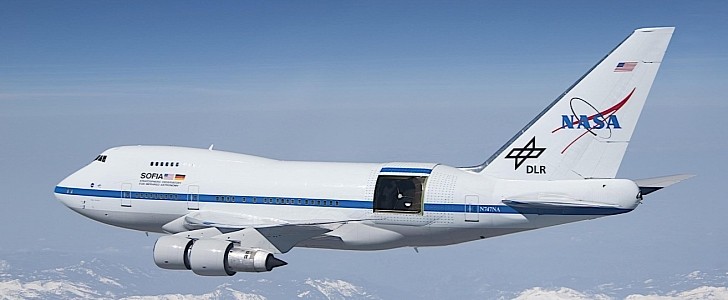Telescopes come in all shapes and sizes, depending on use, and can be placed anywhere, from facilities down here on Earth to floating free, millions of miles away from our planet. But if they’re truly special, telescopes can also be airborne, carried around in converted passenger airliners.
That’s exactly what the Stratospheric Observatory for Infrared Astronomy, or SOFIA for short, is: a Boeing 747SP aircraft, modified to be able to carry a 2.7-meter (106-inch) reflecting telescope, whose sole mission was to “observe the infrared universe," and advancing our understanding of it.
Having a telescope fly is a sort of a compromise between the results you get from land-based ones, which have to fight to get their vision past the Earth’s atmosphere, and space-based ones, which are a lot more effective at their jobs. The Boeing is capable of carrying the telescope at altitudes of up to 45,000 feet (13,700 meters), placing it well above the infrared-blocking atmosphere. And it did so for about five years, with its main mission concluding in 2019.
Back then, SOFIA got a three-year extension, and that allowed it to keep flying and gather data that will be available in “NASA’s public archives for astronomers worldwide to use.” But the telescope’s adventure will end this year, after the parties involved announced they’ve decided to pull the plug.
NASA, the German Space Agency, and Deutsches Zentrum für Luft- und Raumfahrt (DLR) announced this week they’ve decided to conclude the SOFIA project, effective September 2022, when the current extension expires.
The reason for the decision is that “SOFIA’s science productivity does not justify its operating costs,” and its capabilities “do not significantly overlap with the science priorities.”
It’s unclear at this point what will happen to the telescope or the aircraft that allowed it to fly above all others.
Having a telescope fly is a sort of a compromise between the results you get from land-based ones, which have to fight to get their vision past the Earth’s atmosphere, and space-based ones, which are a lot more effective at their jobs. The Boeing is capable of carrying the telescope at altitudes of up to 45,000 feet (13,700 meters), placing it well above the infrared-blocking atmosphere. And it did so for about five years, with its main mission concluding in 2019.
Back then, SOFIA got a three-year extension, and that allowed it to keep flying and gather data that will be available in “NASA’s public archives for astronomers worldwide to use.” But the telescope’s adventure will end this year, after the parties involved announced they’ve decided to pull the plug.
NASA, the German Space Agency, and Deutsches Zentrum für Luft- und Raumfahrt (DLR) announced this week they’ve decided to conclude the SOFIA project, effective September 2022, when the current extension expires.
The reason for the decision is that “SOFIA’s science productivity does not justify its operating costs,” and its capabilities “do not significantly overlap with the science priorities.”
It’s unclear at this point what will happen to the telescope or the aircraft that allowed it to fly above all others.






